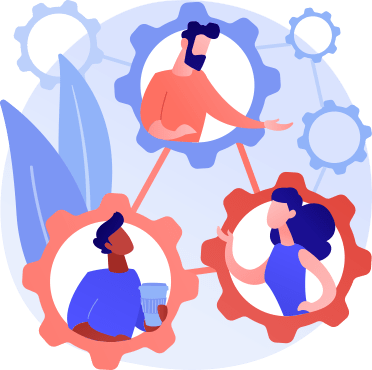CHAPTER 3
Coaching For Leaders: How To Transition
Coaching for leaders takes patience and practice.
As you reflect on integrating coaching skills into leadership, you need to understand that while it’s something anyone can learn, it’s not something that arises organically and naturally for a lot of people.
This is especially true for experienced leaders who are accustomed to guiding their teams to success using traditional leadership skills.
For these leaders, incorporating coaching into their leadership style isn’t just about learning new coaching skills, but it’s about “unlearning” many of the outdated leadership practices that are deeply embodied in their psyche.
Q: How can you do this in the fastest and most effective way?
A: Introduce a transition phase into your learning trajectory.
The transition phase is like a bridge that you need to cross as you learn to coach as a leader.
During this phase, you will gradually but consistently shed some of the leadership patterns and habits that took you up to the level you’re at now, but will take you no further.
The truth is, when you keep working with the same tools and techniques over and over again, your progress as a leader slows and then declines to a halt -- it may even de-accelerate.
For instance, a lot of experienced leaders find themselves stuck in old ways as the world and the workplace continue to progress and change at breakneck speed.

When leaders work with outdated leadership techniques, there is often a distinct lack of creativity or innovation in the organization, and low likeability ratings from colleagues and team members.
Old-school leaders who are stuck in their ways rarely take the opportunity to learn new skills (and this includes personal growth skills), and so, they’re often off the mark when it comes to making insightful, critical decisions which can lead to major challenges and massive obstacles for the business or company.
If you don’t want these issues popping up in your organization or company, you need to consciously switch out the outdated with the new.
Start by becoming aware of the leadership patterns that are no longer bringing you the results and benefits you’re hoping for. Then, adopt and adapt to fresh, effective new ways of creating success in your business or company and for your team members on an individual level, using coaching skills.
Q: What do you need to look out for during this transitional phase?
A: This might seem strange – maybe a little bit personal – but what you want to do first is to check your ego at the door.
This is not to offend or to create a sense of self-doubt, but it’s crucial that you begin your transition into coaching as a leader and your role in your company or business with a sense of curiosity, excitement and a thirst for knowledge as all great coaches do.
This is very different from the “I know what needs to be done, every time” that can be quite common among leaders.
Coaches are hungry for improvement and they are not afraid of change, and this is in fact related to the Beginner’s Mindset (check out Chapter 2).

When you approach your role as a leader through the lens of a coach, what happens is that you step away from “instruction mode” whenever there’s a problem or team meeting.
This hierarchical “the-leader-knows-all” structure can feel intimidating and squelch creativity but when you let it go, these issues quickly dissolve and create room to nurture a sense of camaraderie. This lets everyone work together and come up with truly innovative and creative insights, ideas, and solutions -- as a team.
Another element to focus on during your transition into coaching as a leader is to look at ways where you can be more approachable and available for team members to connect with you through honest, informal conversations.
Whatever you do, don’t wait for formal appraisals to speak to people.
Appraisals often feel restrictive and judgmental, and a lot of people feel too anxious and afraid to be fully truthful about the problems that they face or the support and help they might need to get their jobs done well.
Informal conversations, on the other hand, is a great path to uncover hidden problems that could eventually create deep issues and lead to the collapse of significant projects – and maybe even the entire company.
Allowing an “open door” policy where your employees or team members have access to you when they come across issues or challenges in their day to day work will go a long way to stop this from happening.
This is not to say that you must give up all of your time towards chatting with team members, but it does mean that you need to make it clear that you are open to talking to them and supporting them when they need your help and support.

The following questions will help you identify gaps between where you are now and where you want to be as you transition into becoming a leader-coach.
Question #1
What are some of the old leadership habits and patterns that you’d like to re-evaluate as you transition into integrating coaching into your leadership style? What are some of the leadership techniques that aren’t working anymore?
(eg: too many formal team meetings, closed door policy, emphasizing productivity over creativity, etc)
Question #2
How can you stay humble in your role as a leader? How can you demonstrate to your team members that you value their contributions, skills, and creativity?
Question #3
How can you become more approachable? What can you change in your attitude and communication style that lets people know you’re open to having honest conversations?
Question #4
How can you start to incorporate an “open door” policy so your team members feel like they can come to you when they’re facing challenges and issues in their day-to-day work?
CHAPTER 4
The “How-To” Of
Coaching For Leaders
You’ve discovered the skills and traits you need to cultivate when you want to coach as a leader and how you can approach your role through the lens of a coach.
These are the foundational pillars of understanding and now you’re ready to take action and implement with a framework that actually works to help you lead your team members and your organization as a whole, with the very best that coaching has to offer.

Master coach and co-founder of Evercoach, Ajit Nawalkha, frequently works with this method to magnify his team’s productivity, creativity, focus, and function.
First thing to know is that you need to appeal to the core – the heart and soul – of your team members to get real buy-in from every individual in your organization.
One of the biggest things you can do to fast-track this objective is to be crystal clear on the following elements:

Framework Element #1:
Vision and Mission
The vision and mission of any company are essentially the “why” of the company’s existence and the overarching goals that drive all decisions – from product development, to investment, to hiring and growth.
When there is weak understanding around the company vision and mission, everyone ends up doing their “own thing” based on what they believe is true.
This can quickly create a tangled snarl in day-to-day operations as well as in the overall progress of the organization.
Think about it this way… if there are 10 people with 10 different ideas on what the company is trying to accomplish and also why the company exists, you’re going to come to a total standstill.
Remember… no company, no matter how great, can survive a team that has no idea what they’re actually trying to achieve in their daily work.
Framework Element #2:
Individual Contribution
The first element in this framework has to do with the bigger “why” of the company, but this next element has to do with lasering in on individual goals and the individual “why.”
The most successful, creative and productive teams are made up of members who are clear on why they do what they do in the company.
They are also very clear on how their contribution affects and transfers into the overall success of the company.
If your team members are uncertain about this, expect a lot of turnover in your team. When people are unclear of their contribution it kills initiative, creativity, proactive actions, and it quickly leads to demotivation.
Framework Element #3: Roadblocks and Challenges
The road to success is not a straight line, it’s not smooth and it’s definitely not predictable.
This is one of the reasons why it’s super important that you encourage team members to shine the light of awareness on the smaller signs that show there is trouble on the horizon.
For instance, there may be customer complaints around the same issues regarding a specific product or offer.
Catching this and solving the problem could lead to huge savings in time and money – not to mention the reputation of the company – down the line.
Framework Element #4:
Growth and Expansion
Companies that don’t grow don’t fail… they die.
This is an undeniable truth and the most effective antidote to shutting your doors for good is to continuously encourage growth by seeking out ways to improve, change and become better.
This is where you get to shine in coaching as a leader because this is where you get to show up and model the behavior you want to encourage in your team members.
Reflect on how you can improve, every single day, then take action.
Doing this will serve as a huge inspiration to the ones you lead and it will create a culture where everyone in your organization is always improving – a guaranteed path to overall growth and expansion for the company.
Framework Element #5:
Support and Guidance
Leaders who successfully coach their teams are constantly focusing on what they can do to help and support others.
This is about thinking up ways to connect and create authentic relationships built on trust.
Always take the initiative to communicate with your team members and let them know you are there for them. This will give them the confidence they need to come to you for support and guidance. (Check out Chapter 3 for ideas on how to do this)

The coaching as a leader framework can be represented with a handful of powerful questions. Each of these questions is perfectly mapped to each of the elements discussed in this chapter.
Work on these questions yourself and then share with your team members. Keep in mind that there is no room for judgment here -- just honest and open discussions.
Framework Element #1: Vision and Mission
Question #1
What do you think is the vision and mission of this organization?
Framework Element #2: Individual Contribution
Question #2
What do you believe is your current role and what are your contributions toward the vision and mission of this organization?
Framework Element #3: Roadblocks and Challenges
Question #3
What are some of the roadblocks that you are facing as an individual or that the organization is facing, and how do you think they can be overcome?
Framework Element #4: Growth & Expansion
Question #4
How can you improve as a leader and how can your team members be better as a team?
Framework Element #5: Support and Guidance
Question #5
What can I do to support and guide my team members and the team, overall? How can I make their lives easier and better?
